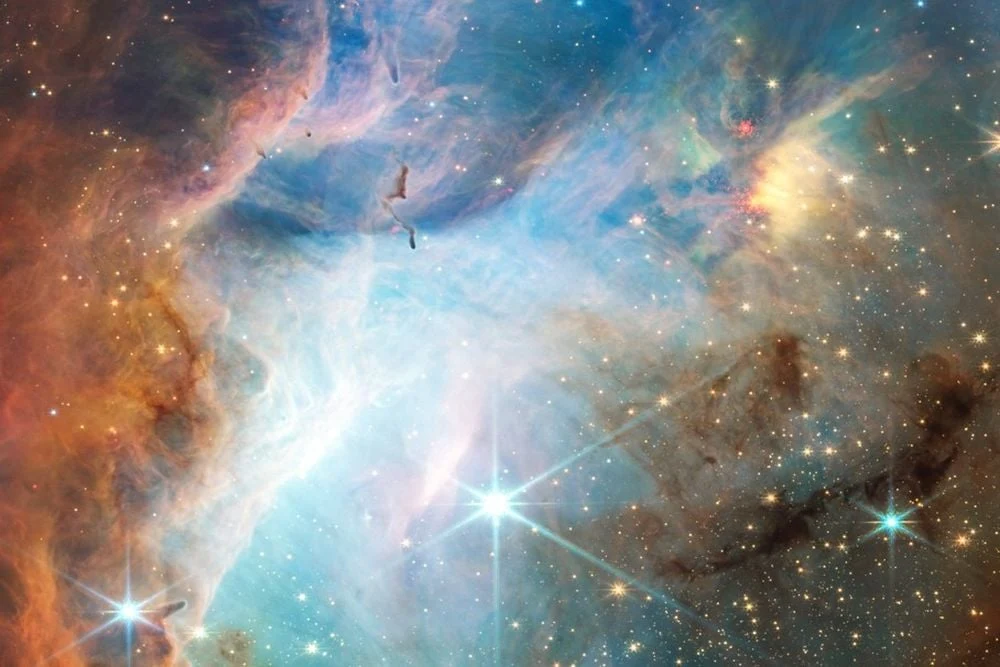
This is a zoomed-in portion of the JWST's Cat's Paw image. It shows a cavity surrounded by filaments and clumps of gas and dust. The cavity has been hollowed out by a hot young star which lights its surroundings up in blue.
Image Credit: NASA, ESA, CSA, STScI
To celebrate its third anniversary, astronomers used the NASA/ESA/CSA James Webb Space Telescope to scratch beyond the surface of the Cat’s Paw Nebula (NGC 6334), a massive, local star-forming region.
This is what they saw. Compare it to the description of the universe in the Bible - a small flat planet with a dome over it at the center, with the sun and moon attached to the dome and stars stuck to its underside, able to be shaken lose in earthquakes.
Here is what the late great Carl Sagan had to say about how religions view the universe:
How is it that hardly any major religion has looked at science and concluded, “This is better than we thought! The Universe is much bigger than our prophets said, grander, more subtle, more elegant?” Instead, they say, “No, no, no! My god is a little god, and I want him to stay that way.” A religion, old or new, that stressed the magnificence of the Universe as revealed by modern science might be able to draw forth reserves of reverence and awe hardly tapped by the conventional faiths.
Carl Sagan, Pale Blue Dot: A Vision of the Human Future in Space
What information do you have on the Cats Paw nebula? The Cat’s Paw Nebula—also known as NGC 6334—is a prominent emission nebula located in the constellation Scorpius. Here's a detailed overview of what is known about it:
General Overview
- Common Names: Cat’s Paw Nebula, Bear Claw Nebula, NGC 6334
- Object Type: Emission nebula and H II region
- Distance from Earth: Approximately 5,500 light-years (1,700 parsecs)
- Size: Roughly 50 light-years across
- Apparent Size: \~40 arcminutes (larger than the Full Moon)
- Location: Southern celestial hemisphere, near the tail of Scorpius
Structure and Appearance
- The nebula gets its name because of its resemblance to a cat’s paw print, with bright, rounded "pads" formed by dense regions of gas and dust.
- Composed mostly of ionised hydrogen (H II), the nebula glows red due to the intense ultraviolet radiation emitted by massive young stars embedded within.
- The surrounding dust clouds are dense and opaque in visible light but transparent in infrared, revealing hidden star-forming regions.
Star Formation
- NGC 6334 is one of the most active star-forming regions in our galaxy.
- It contains dozens of massive protostars and young stellar objects (YSOs).
- Many of these stars are OB-type, extremely hot and luminous, and are responsible for ionising the gas.
- The region hosts massive stellar clusters as well as infrared sources such as NGC 6334I, one of the most massive protostellar systems known in the Milky Way.
Scientific Significance
- The Cat’s Paw Nebula is frequently studied in infrared, radio, and submillimetre wavelengths because the dense dust obscures much of the visible light.
- It provides astronomers with valuable insights into:
- High-mass star formation
- Molecular cloud dynamics
- Infrared emission from dust and gas
- The interaction between stellar winds and interstellar material
Observations and Imagery
- It has been imaged by several major telescopes:
- Spitzer Space Telescope (infrared)
- Hubble Space Telescope (visible and near-infrared)
- ESO’s VISTA and VLT in Chile (infrared/optical)
- Chandra X-ray Observatory (revealing young stars and high-energy processes)
Related Nebulae
- It is located near NGC 6357 (the Lobster Nebula), another active star-forming region. Both are often studied together due to their proximity and similar characteristics.
- Both are part of the Scorpius OB1 association, a loose group of massive young stars.

Brilliant stars light up their surroundings in this region of the Cat's Paw Nebula. Near the top of the image, small, dense clumps of gas and dust are holding their own against the furious energy of the stars.
Image Credit: NASA, ESA, CSA, STScI

Thick dust dominates this region of the Cat's Paw Nebula.
Image Credit: NASA, ESA, CSA, STScI
Images like these starkly highlight the vast gulf between the universe as it truly is and the limited cosmological imaginings of uneducated Bronze Age pastoralists. Their descriptions—deeply rooted in myth and metaphor—are so far removed from reality that it takes extraordinary intellectual gymnastics to present them as anything approaching allegorical insight, let alone scientific understanding.
What science is now revealing about the majesty, scale, and complexity of the cosmos leaves little doubt that the biblical account of creation could not have been authored or inspired by the kind of all-knowing deity it describes. To cling to the idea that the Bible offers a literal and scientifically accurate portrayal of the universe, creationists must embrace the mindset Carl Sagan so aptly critiqued: "No! No! Ours is a small God, and we insist it stays that way!"
Advertisement
All titles available in paperback, hardcover, ebook for Kindle and audio format.
Prices correct at time of publication. for current prices.

.jpg)









No comments:
Post a Comment
Obscene, threatening or obnoxious messages, preaching, abuse and spam will be removed, as will anything by known Internet trolls and stalkers, by known sock-puppet accounts and anything not connected with the post,
A claim made without evidence can be dismissed without evidence. Remember: your opinion is not an established fact unless corroborated.